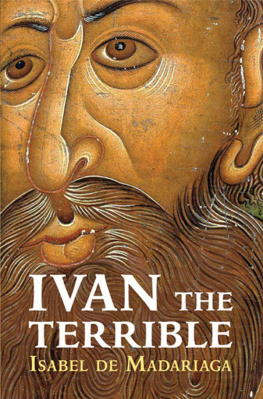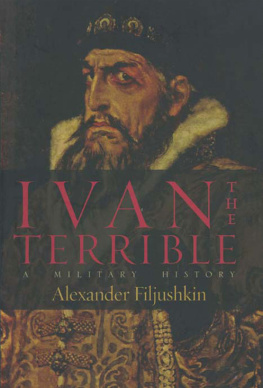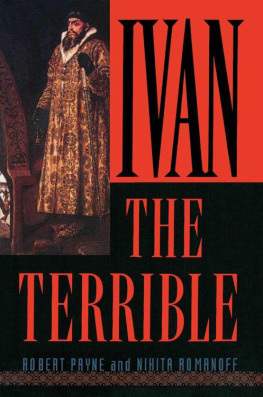Ivan the Terrible
Ivan the Terrible
First Tsar of Russia
Isabel de Madariaga
Yale University Press
New Haven and London
Copyright 2005 by Isabel de Madariaga
All rights reserved. This book may not be reproduced in whole or in part, in any form (beyond that copying permitted by Sections 107 and 108 of the U.S. Copyright Law and except by reviewers for the public press), without written permission from the publishers.
For information about this and other Yale University Press publications, please contact:
U.S. Office: sales.press@yale.edu yalebooks.com
Europe Office: sales@yaleup.co.uk www.yalebooks.co.uk
Set in Sabon by MATS, Southend-on-Sea, Essex
Printed in Great Britain by St Edmundsbury Press Ltd, Bury St Edmunds
Library of Congress Cataloging-in-Publication Data
De Madariaga, Isabel, 1919
Ivan the Terrible/Isabel de Madariaga. 1st ed.
p. cm.
Includes bibliographical references and index.
ISBN 0300097573 (cl.: alk. paper)
1. Ivan IV, Tsar of Russia, 15301584. 2. RussiaTsars and rulersBibliography. 3. RussiaHistoryIvan IV, 15331584. I. Title.
DK106.D4 2005
947.043092dc22
2004029807
A catalogue record for this book is available from the British Library.
10 9 8 7 6 5 4 3 2 1
Contents
Illustrations

1. The christening of Ivan IV, miniature from the Litsevaia Chronicle.
2. The coronation of Ivan IV, miniature from the Litsevaia Chronicle.
3. The execution of boyars near Kolomna in 1546, miniature from the Litsevaia Chronicle.
4. The wedding of Ivan IV and Anastasia, miniature from the Nikon Chronicle (akg-images).
5. The fire in Moscow in 1547, miniature from the Litsevaia Chronicle.
6. The Church Militant, icon, c. 1550s, Tret'yakov Gallery, Moscow.
7. Benozzo Gozzoli, The Journey of the Magi, wall painting, Palazzo Medici Riccardi, Florence ( 1993, Photo Scala, Florence courtesy of the Ministero Beni e Att. Culturali).
8. The departure of an ailing Anastasia from Moscow in flames, miniature from the Litsevaia Chronicle.
9. Monastery of St Cyril of the White Lake (author's photograph).
10. A session of the Boyar Council, miniature from the Litsevaia Chronicle.
11. Ivan IV bids farewell to Richard Chancellor and Osip Nepea on their return to England, miniature from the Litsevaia Chronicle.
12. Interpolations in the Litsevaia Chronicle, c. 1569July 1570.
13. Ivan IV receives the letter from Prince Kurbsky in 1564, miniature from the Litsevaia Chronicle.
14. Peasants cutting wood, miniature from the Litsevaia Chronicle.
15. Princess Evfrosin'ia of Staritsa.
16. Michael Peterle, Russian envoys to the diet of Regensburg in 1576, woodcut (V&A Images/Victoria and Albert Museum).
17. Stephen Bathory (Mary Evans Picture Library).
18. Sigismund II Augustus (Mary Evans Picture Library).
19. Still from Sergei Eisenstein, Ivan Groznyi (part I), 1945 (Alam Ata/Album/akg-images).
Maps
Russia and PolandLithuania, mid-sixteenth century
Livonia and north Russia
Areas incorporated into the oprichnina
Foreword
The complex historiography of the reign of Tsar Ivan IV is usually expounded in detail in the first chapters of most late nineteenth- and twentieth-century works on Russian history. It is a highly politicized historiography because at all stages since the beginning of the nineteenth century, historians have only too often forgotten that history is about human beings, and have been wedded to one or another theory of the interpretation of historical trends: Hegelianism, economic determinism, populism, historical materialism, Marxism, Eurasianism, economic materialism, MarxismLeninism, most of which theories are at all times difficult to apply to a pre-modern society.
I have carried out no original research in Russian archives for this book, but have relied entirely on published sources and historical works. Among older historians I have drawn often on N.M. Karamzin whose Istoria gosudarstva rossiikogo appeared between 1814 and 1824 the last of the Chronicles and the first of the histories, as Pushkin put it. It is invaluable not just for the simplicity and humanity of its moral approach, but also for the richness of the sources quoted in the footnotes, some of which have now been lost. I have also made ample use of S.M. Solov'ev's Istoria Rossii s drevneishikh vremen (185179), for he also quotes extensively from sources, though I do not share his reliance on the state as the motor of history. V.O. Kliuchevsky, one of the most balanced of Russian historians, does not attribute any ultimate political significance to Ivan's oprichnina, and sees it as the product of the excessively fearful imagination of the Tsar. His conclusion that it was directed against persons and not against a system revived the conception of the moral rather than the political role of the Tsar, but though Kliuchevsky's judgments are always valuable, he has not devoted so much of his time specifically to writing about Ivan IV.
A bourgeois historian stands out as bestriding the transition from
While historiography floundered in ideological rapids, the Russian intelligentsia, and intellectuals in general, developed their own unprofessional, but human views of the Tsar. The Decembrist Kondratii Ryleev called him a tyrant, and Mikhail Lunin wrote of the mad Tsar who for twenty-four years bathed in the blood of his subjects. Belinsky wrote of a fallen angel who revealed at times both the strength of an iron character and the strength of an exalted mind.
Soviet historiography presented particular problems, such as the need to apply rigid Marxist criteria to the analysis of what had actually happened, without agreement having been reached on what the Marxist criteria actually were or on what had actually happened.
Platonov's rival in the transition period was Pokrovsky himself, a committed Marxist and a bolshevik, who dominated the historical scene until the mid-1930s. His Russian History from Earliest Times, was published before the Revolution. He attributed the institution of the oprichnina to the victory of the monetary economy over the feudal natural economy, leading to an alliance between the service gentry and the merchant bourgeoisie and disregarding the personal influence of Ivan IV. By 1936 (after his death) he was denounced as anti-Marxist and anti-Leninist. More important, though difficult to classify, was the work of R. Wipper, which in different versions appeared in 1922 and in 1942, when it glorified Ivan as a leader and statesman. But it would be unjust to assume that historians and for that matter playwrights or historical novelists were all cast in one ideological mould, and new interpretations of Ivan's reign emerged into history and literature, reflecting individual judgments and the twists and turns of Soviet foreign policy and alliances. Victim of these changes of direction was S.B. Veselovsky, one of the greatest scholars of mid-sixteenth century Russia, who reverted, mid-twentieth century, to the position of Kliuchevsky, that the oprichnina served no political purpose, and who was therefore attacked as non-Marxist and whose work was stifled.
At this point Stalin's interest in Russian history becomes more noticeable, and it culminated in his influence on the novels of A.N. Tolstoy and the films about Aleksander Nevsky and Ivan Groznyi, of Eisenstein, the second of which was commissioned by Stalin in 1941 before the German invasion of Russia, during the period of the Nazi-Soviet pact. The treatment of the subject reflects the changing political situation, and Ivan, though a Tsar, is depicted, in Part I of Eisenstein's film, as a wise statesman, leader of his people, opposed by treacherous boyars and supported by the common people.
Next page












